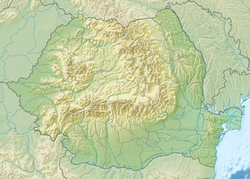
Back دلتا الدانوب Arabic Delta del Danubiu AST Dunay deltası Azerbaijani Дэльта Дуная Byelorussian Дэльта Дунаю BE-X-OLD Делта на Дунав Bulgarian Delta Dunava BS Delta del Danubi Catalan Danube Delta CEB Delta Dunaje Czech
| UNESCO World Heritage Site | |
|---|---|
 | |
| Location | Tulcea County, Romania and Odesa Oblast, Ukraine |
| Criteria | Natural: vii, x |
| Reference | 588 |
| Inscription | 1991 (15th Session) |
| Area | 312,440 ha |
| Coordinates | 45°12′N 29°30′E / 45.200°N 29.500°E |
| Designated | 21 May 1991 |
| Reference no. | 521[1] |
The Danube Delta (Romanian: Delta Dunării, pronounced [ˈdelta ˈdunərij] ; Ukrainian: Дельта Дунаю, romanized: Del'ta Dunaju, pronounced [delʲˈtɑ dʊnɐˈju]) is the second largest river delta in Europe, after the Volga Delta, and is the best preserved on the continent.[2] Occurring where the Danube River empties into the Black Sea, most of the Danube Delta lies in Romania (Tulcea County), with a small part located in Ukraine (Odesa Oblast).[3][4] Its approximate surface area is 4,152 square kilometres (1,603 square miles), of which 3,446 km2 (1,331 sq mi) is in Romania. With the lagoons of Razim–Sinoe (1,015 km2 or 392 sq mi with 865 km2 or 334 sq mi water surface), located south of the main delta, the total area of the Danube Delta is 5,165 km2 (1,994 sq mi). The Razim–Sinoe lagoon complex is geologically and ecologically related to the delta proper; the combined territory is listed as a World Heritage Site.
- ^ "Danube Delta". Ramsar Sites Information Service. Archived from the original on 8 April 2022. Retrieved 25 April 2018.
- ^ "Danube Delta – UNESCO World Heritage Centre". Archived from the original on 2008-01-27. Retrieved 2019-12-26.
- ^ Biosphere Reserves in Ukraine, UNESCO. [Retrieved 2 June 2019].
- ^ Biosphere Reserves: Danube Delta, UNESCO. [Retrieved 2 June 2019].
